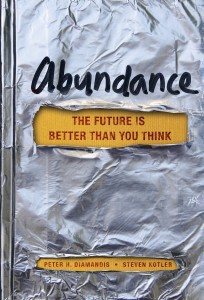Abundance Authors Diamandis and Kotler Answer Your Questions

 We recently solicited your questions for Peter Diamandis, founder and CEO of the X Prize Foundation, and journalist Steven Kotler. They are co-authors of the new book Abundance: The Future Is Better Than You Think. Below are their answers about the need for jobs (it’s not what you may suspect), the distribution of wealth, and the technological breakthrough that led the price of aluminum to plummet. Thanks to everyone for participating.
We recently solicited your questions for Peter Diamandis, founder and CEO of the X Prize Foundation, and journalist Steven Kotler. They are co-authors of the new book Abundance: The Future Is Better Than You Think. Below are their answers about the need for jobs (it’s not what you may suspect), the distribution of wealth, and the technological breakthrough that led the price of aluminum to plummet. Thanks to everyone for participating.
 Q. How did you come up with the book’s cover art? It’s very eye-catching — but not obviously related to the subject matter. –nobody.really
Q. How did you come up with the book’s cover art? It’s very eye-catching — but not obviously related to the subject matter. –nobody.really
A. The cover is actually directly related to the book’s message. The book is “wrapped” in aluminum foil and the story of aluminum is what opens Abundance. In short, during the early 1800s aluminum was considered the most valuable metal in the world. This is why the capstone to the Washington Monument is made from aluminum, and also why Napoléon III himself threw a banquet for the king of Siam where the honored guests were given aluminum utensils, while the others had to make do with gold.
Technically, behind oxygen and silicon, aluminum is the third most abundant element in the Earth’s crust, making up 8.3 percent of the weight of the world. However, aluminum is tightly bound in a clay-like material called bauxite. While bauxite is 52 percent aluminum, separating out the pure metal ore was a complex and difficult task. It was the creation of a new breakthrough technology known as electrolysis, discovered independently and almost simultaneously in 1886 by American chemist Charles Martin Hall and Frenchman Paul Héroult that changed everything. The Hall-Héroult process, as it is now known, uses electricity to liberate aluminum from bauxite. Suddenly everyone on the planet had access to ridiculous amounts of cheap, light, pliable metal. Today aluminum is cheap, ubiquitous, and used with a throwaway mind-set.
The point is this: when seen through the lens of technology, few resources are truly scarce; they’re mainly inaccessible. Yet the threat of scarcity still dominates our worldview. The amount of solar energy that hits our atmosphere has been well established at 174 petawatts (1.740 x 10^17 watts), plus or minus 3.5 percent. Out of this total solar flux, approximately half reaches the Earth’s surface. Since humanity currently consumes about 16 terawatts annually (going by 2008 numbers), there’s over five thousand times more solar energy falling on the planet’s surface than we use in a year. Once again, it’s not an issue of scarcity, it’s an issue of accessibility. Take another example: water. The Earth itself is a water planet, covered 70 percent by oceans. But 97.3 percent of all water on this planet is salt water. What if, though, in the same way that electrolysis easily transformed bauxite into aluminum, a new technology could desalinate just a minute fraction of our oceans?
Q. If we live in a time of abundance, why do we have unemployment? And why are we still using money? –Dave
A. That is not the argument being made in Abundance. What we are saying is that because of four emerging forces (see below) humanity now has the ability to significantly improve global standards of living over the next two-to-three decades. By abundance, we do not mean a life of luxury, we mean meeting and exceeding the basic needs of every man, woman and child on the planet.
So what are those four forces?
- Exponential Technologies: Over the past few decades, researchers have come to conclude that any information-based technology is advancing along exponential growth curves. This is why the cell phone in your pocket is as powerful as a mid-70s era supercomputer for a minute fraction of the cost. But besides communication technology, exponential forces are at work in computational and network systems, artificial intelligence, robotics, biotechnology, bio-informatics, nanotechnology, human-machine interfaces, and many more. These technologies will soon enable the vast majority of humanity to experience what only the affluent have had access to thus far. In Abundance, we examine how exponential technologies are being used (and can be used) to provide 7 billion people with clean water, nutritious food, affordable housing, personalized education, top-tier medical care, non-polluting and ubiquitous energy.
- DIY Innovators: DIY innovators are individuals and small groups empowered by exponential technologies and driven by the desire to take on humanity’s grand challenges. As we explore in the book, these groups now have the ability to tackle problems that were once the sole domain of governments and major corporations and NGOs. As a result, we are at the front end of a DIY revolution unlike anything the world has yet seen.
- Technophilanthropists: Today there are more than 1,400 billionaires and 93,000 “ultra-high-net-worth” individuals in the world. Many of these are young, very socially-conscious entrepreneurs who made their money in technology and are now interested in using it to slay some of the world’s grandest challenges. Bill Gates fighting against malaria, Jeff Skoll crusading against pandemics, Pierre Omyidar democracy-spreading efforts. There are many, many more. We call these individuals Technophilanthropists.
- Rising Billion: These are the poorest people on Earth, the so-called “bottom billion.” We have renamed this group the “Rising Billion” because, thanks to the exponential spread of communication and information technologies (like the smart phone), these people are coming online for the very first time. Their voices, which have never before been heard, are suddenly joining the global conversation. Aided by these technologies, the Rising Billion are beginning to pull themselves out of poverty. They are already on their way to becoming a powerful and significant consuming segment of humanity, and many companies are rushing to develop ultra-low cost products to meet their needs. This effort will drive down the price of basic goods and services in a fashion that will benefit everyone. But the Rising Billion are also become a producing and consuming segment of humanity, generating new ideas, insights, products and services that add to the overall wealth of Earth.
Q. Even if the world becomes vastly richer in aggregate, by what mechanism do the authors see this wealth distributed? –nobody.really
A. The better question might be—by what mechanism is this wealth not distributed. To throw a few quick numbers around: poverty has decreased more in the past 50 years than in the previous 500 years. Adjusted for inflation, i
ncome over the past century has tripled. Also, as I’m sure most will agree, income is a fairly paltry measure of the gap between rich and poor. Equally important are things like human rights, personal freedom, protection against violence, access to healthcare, access education, etc.—all of which have been trending upwards (violence is 100-fold lower than it was in the Middle Ages, for example).
The best example of this (or at least the most visually-enticing example) is Hans Rosling’s now famous TED talk on the subject.
But it’s the digital revolution that is fostering the greatest gains. In Africa today a Masai warrior on a cellphone has better mobile communications than the President did 25 years ago; if he’s on a smartphone with Google, he has access to more information than the President did just 15 years ago. Also consider the feast of standard smart phone features: watch, stereo, camera, video camera, voice recorder, GPS tracker, video teleconferencing equipment, a vast library of books, films, games, music. Just 20 years ago these same goods and services would have cost over $1 million. We borrow Bill Joy’s term for this process: dematerialization—and it is a mighty engine of distribution.
Q. Abundance requires a stable political and physical environment, both of which are disappearing! – O.A.Wehmanen
A. There’s two answers to this question—we’ll start with environmental stability. The environment is unstable because of human impact. There is no greater example of this than the giant biodiversity die-off scientists are calling “the Sixth Great Extinction.” Interestingly, this is not a problem without a solution. Environmentalists have known since the sixties that the easiest way to slow this slide is land—we need to repurpose land that is currently being used by humans; we need to give it back to nature. So how is this possible? Well, the easiest way is to design our agricultural systems: to grow more food on less land. This is exactly what the technologies described in Abundance provide. By combining vertical farming, genetically engineered crops and in-vitro meat, we not only radically reduce human inputs into the eco-system (less water required, fewer pesticides, better soil preservation, reduction in food miles, etc), we also free up enormous swatches of land. Cattle, for example, use 30 percent of the land on Earth. In vitro meat—essentially the process of growing hamburger from stem cells inside a giant bio-reactor (and a process that is already feasible today)—frees up all of this land. The point here is that the technologies that allow us to raise basic standards of living are same as the ones that further stabilize the environment.
On the flip side, the rapid growth rate in technology is certainly destabilizing governments and legacy businesses—that much is certain. But right now, as previously mentioned, small groups of dedicated individuals can now take on the types of grand challenges that were once the sole province of governments. Dean Kamen, for example, has invented a water purifier he calls “the slingshot.” It can turn anything wet—salt water, latrine water, arsenic-laden water—into injectable grade sterile water for less than .02 cents a gallon (an using less energy than it takes to run a hair dryer). 20 years ago, water shortages were problem for the UN or the World Bank. Today, solitary inventors can impact the lives of billions. So while governments are struggling to keep up with the change, individuals can step in and do an increasingly better job.
Moreover, our growing tools of cooperation allow for things like crowdsourcing and micro-financing and the like. Consider Foldit, the crowdsourced protein folding game created by graduate students at the University of Washington. In 2011, over a period of just ten days, Foldit players deciphered the structure of an AIDs causing monkey virus that had puzzled scientists for the past fifteen years (a discovery that could lead to new medicines). In 2012, Foldit players increased the catalytic speed of one of the most useful reactions in organic chemistry (the Diels-Alder reaction) by more than eighteen fold (thus speeding up our collective molecular manufacturing capacity considerably).
These are world-bettering results produced by hobbyists (the world’s best protein folder is a woman from Manchester, England, who, by day, is an executive secretary in a rehab clinic) and they are only the beginning. The relentless acceleration of technology is only going to continue and, as is definitely evidenced by recent economic events, both governments and legacy businesses will struggle to keep up. This means that if we truly are going to solve our grand challenges and create a world of abundance, DIY innovators are going to be fundamental to the effort.
Q. You arrive at your conclusion of “abundance” by arbitrarily placing a high value on those things that might be expected to be produced in your techno-future, and greatly devaluing those things – open space, privacy, peace & quiet – that it is destroying. Care to comment? –James
A. One of the surest way to protect open spaces, peace and privacy is to reduce population growth. The only way to do this is to increase global standards of living (specifically to provide clean water, education and freedom for women). Therefore the very transition being discussed in Abundance fulfill many of these needs.
Q. What’s with the flap copy claim “since the dawn of humanity, a privileged few have lived in stark contrast to the hardscrabble majority?” Isn’t the exact opposite true? Namely that agrarian societies were more socialist as far as resource distribution, and that stratification has increased over time — that it’s not some sort of static ‘state of nature’? Will abundance induced unemployment will turn a Utopia into a Dystopia? – frankenduf
A. It’s a long answer and the only way to get at it is to quote liberally from our “Dangers of Exponentials” appendix…. Here goes:
No one is entirely certain, though it’s helpful to remember this isn’t the first time automation changed the employment landscape. In 1862, 90 percent of our workforce were farmers. By the 1930’s, the number was 21 percent. Today, it’s less than 2 percent. So what happened to the farm jobs that were displaced by automation? Nothing fancy. The old low-skill jobs were replaced by new higher-skilled jobs and the workforce was trained to fill them. This is the way of progress. In a world of ever-increasing specialization, we are constantly creating anew. “At a high level,” says Second Life creator Philip Rosedale, “humans have consistently demonstrated an ability to find new things to do that are of greater value when jobs have been outsourced or automated. The industrial revolution, outsourced IT work, China’s low-cost labor force, all ultimately created more interesting new jobs than they displaced.”
Vivek Wadhwa, Director of Research at the Center for Entrepreneurship at Duke University, agrees:
“Jobs that can be automated are always at risk. Society’s challenge is to keep moving up the ladder, into higher realms. We need to create new jobs that use human creativity rather than human labor. I admit that it’s difficult to conceive of the jobs of the future because we have no idea what technology will emerge and change the world. I doubt anyone could have predicted two decades ago that countries like India would go from being seen as lands
of beggars and snake charmers to an employment threat for the developed world. Americans no longer tell their children to think about starving Indians before wasting the food on their plates, they tell them to study math and science or the Indians will take their white-collar jobs away.”In addition to training up, others might simply retire. SU AI expert Neil Jacobstein explains, “Exponential technologies may eventually permit people to not need jobs to have a high standard of living. People will have many choices with how they utilize their time and develop a sense of self-esteem—ranging from leisure normally associated with retirement to art, music or even restoring the environment. The emphasis will be less on making money, and more on making contributions, or at least creating an interesting life.”
This may seem a fairly future forward opinion, but in a 2011 special report for CNN, media specialist Douglas Rushkoff argued this transition is already underway:
I understand we all want paychecks — or at least money. We want food, shelter, clothing, and all the things that money buys us. But do we all really want jobs?
We’re living in an economy where productivity is no longer the goal, employment is. That’s because, on a very fundamental level, we have pretty much everything we need. America is productive enough that it could probably shelter, feed, educate, and even provide health care for its entire population with just a fraction of us actually working.
According to the U.N. Food and Agriculture Organization, there is enough food produced to provide everyone in the world with 2,720 kilocalories per person per day. And that’s even after America disposes of thousands of tons of crop and dairy just to keep market prices high. Meanwhile, American banks overloaded with foreclosed properties are demolishing vacant dwellings to get the empty houses off their books.
Our problem is not that we don’t have enough stuff—it’s that we don’t have enough ways for people to work and prove that they deserve this stuff.
Part of the problem is that most contemporary thinking about money and markets and such has its roots in the scarcity model. In fact, one of the most commonly used definitions of economics is “the study of how people make choices under conditions of scarcity, and the results of those choices for society.” As Traditional Economics (which believes that markets are equilibrium systems) gets replaced by Complexity Economics (which both fits the data significantly better and believes markets are complex adaptive systems), we may begin to uncover a post-scarcity framework for assessment, but there’s no guarantee that such thinking will result in either more jobs or a different resource allocation system.

Comments